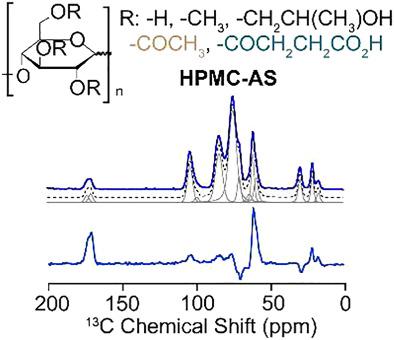当前位置:
X-MOL 学术
›
Magn. Reson. Chem.
›
论文详情
Our official English website, www.x-mol.net, welcomes your feedback! (Note: you will need to create a separate account there.)
Solid State Nuclear Magnetic Resonance Studies of HydroxyPropylMethylCellulose Acetyl Succinate polymer, a Useful Carrier in Pharmaceutical Solid Dispersions
Magnetic Resonance in Chemistry ( IF 2 ) Pub Date : 2020-02-03 , DOI: 10.1002/mrc.4984 Andrea Pugliese 1 , Lucy E Hawarden 2 , Anuji Abraham 3 , Michael Tobyn 2 , Frédéric Blanc 1, 4
Magnetic Resonance in Chemistry ( IF 2 ) Pub Date : 2020-02-03 , DOI: 10.1002/mrc.4984 Andrea Pugliese 1 , Lucy E Hawarden 2 , Anuji Abraham 3 , Michael Tobyn 2 , Frédéric Blanc 1, 4
Affiliation

|
Hydroxypropylmethylcellulose acetyl succinate (HPMC-AS) is a key polymer used for the enablement of amorphous solid dispersions (ASDs) in oral solid dosage forms. Choice of the appropriate grade within the material is often made empirically, by the manufacturer of small scale formulations, followed by extensive real time stability. A key factor in understanding and predicting the performance of an ASD is related to the presence of hydrogen (or other) bonds between the polymer and active pharmaceutical ingredient (API), which will increase stability over the parameters captured by miscibility and predicted by the Gordon-Taylor equation. Solid state Nuclear Magnetic Resonance (NMR) is particularly well equipped to probe spatial proximities, for example between polymer and API, however in the case of HPMC-AS these interactions have been sometimes difficult to identity as the carbon-13 NMR spectra assignment is yet to be firmly established. Using feedstock, selectively substituted hydroxypropylmethylcellulose (HPMC) polymers and NMR editing experiments, we propose here a comprehensive understanding of the chemical structure of HPMC-AS and a definitive spectral assignment of the 13 C NMR spectra of this polymer. The NMR data also captures the molar ratios of the acetate and succinate moieties present in HPMC-AS of various grades without the need for post treatment required by chromatography methods commonly use in pharmacopeia. This knowledge will allow the prediction and measurement of interactions between polymers and APIs, and therefore a rational choice of polymer grade to enhance the solid state stability of ASDs.
中文翻译:

羟丙基甲基纤维素乙酰琥珀酸酯聚合物(药物固体分散体中的有用载体)的固态核磁共振研究
羟丙基甲基纤维素乙酰琥珀酸酯 (HPMC-AS) 是一种关键聚合物,用于在口服固体剂型中实现无定形固体分散体 (ASD)。材料中适当等级的选择通常由小规模配方的制造商凭经验做出,然后是广泛的实时稳定性。理解和预测 ASD 性能的一个关键因素与聚合物和活性药物成分 (API) 之间氢键(或其他)的存在有关,这将增加由混溶性捕获并由 Gordon 预测的参数的稳定性-泰勒方程。固态核磁共振 (NMR) 特别适合探测空间邻近性,例如聚合物和 API 之间,然而,在 HPMC-AS 的情况下,这些相互作用有时难以确定,因为碳 13 NMR 光谱分配尚未牢固建立。使用原料、选择性取代的羟丙基甲基纤维素 (HPMC) 聚合物和 NMR 编辑实验,我们在此建议全面了解 HPMC-AS 的化学结构以及该聚合物的 13 C NMR 光谱的明确光谱分配。NMR 数据还捕获了存在于各种等级的 HPMC-AS 中的乙酸盐和琥珀酸盐部分的摩尔比,无需药典中常用的色谱方法所需的后处理。这些知识将允许预测和测量聚合物和 API 之间的相互作用,从而合理选择聚合物等级以提高 ASD 的固态稳定性。
更新日期:2020-02-03
中文翻译:

羟丙基甲基纤维素乙酰琥珀酸酯聚合物(药物固体分散体中的有用载体)的固态核磁共振研究
羟丙基甲基纤维素乙酰琥珀酸酯 (HPMC-AS) 是一种关键聚合物,用于在口服固体剂型中实现无定形固体分散体 (ASD)。材料中适当等级的选择通常由小规模配方的制造商凭经验做出,然后是广泛的实时稳定性。理解和预测 ASD 性能的一个关键因素与聚合物和活性药物成分 (API) 之间氢键(或其他)的存在有关,这将增加由混溶性捕获并由 Gordon 预测的参数的稳定性-泰勒方程。固态核磁共振 (NMR) 特别适合探测空间邻近性,例如聚合物和 API 之间,然而,在 HPMC-AS 的情况下,这些相互作用有时难以确定,因为碳 13 NMR 光谱分配尚未牢固建立。使用原料、选择性取代的羟丙基甲基纤维素 (HPMC) 聚合物和 NMR 编辑实验,我们在此建议全面了解 HPMC-AS 的化学结构以及该聚合物的 13 C NMR 光谱的明确光谱分配。NMR 数据还捕获了存在于各种等级的 HPMC-AS 中的乙酸盐和琥珀酸盐部分的摩尔比,无需药典中常用的色谱方法所需的后处理。这些知识将允许预测和测量聚合物和 API 之间的相互作用,从而合理选择聚合物等级以提高 ASD 的固态稳定性。

























 京公网安备 11010802027423号
京公网安备 11010802027423号